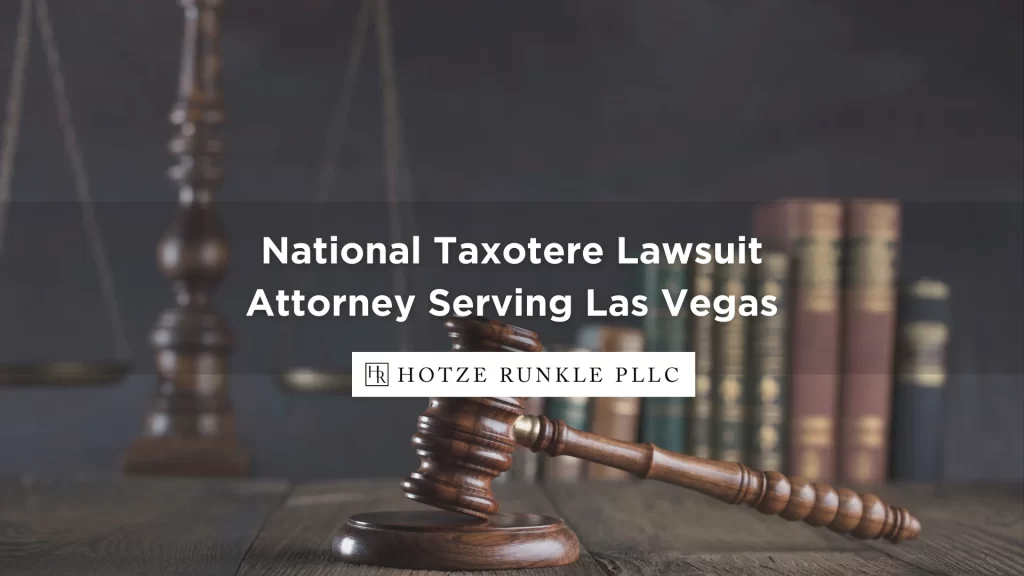
If you took Taxotere for your chemotherapy treatment and you developed an eye condition called canalicular stenosis, you might be entitled to financial compensation. Canalicular stenosis is a serious, permanent eye condition characterized by severe eye-watering, as well as eye irritation, blurred vision, and more.
For nearly 15 years, Hotze Runkle PLLC has been helping clients like you seek justice for the negligent actions of others. Taxotere’s manufacturer failed to warn doctors and patients about the serious risk of taking its drug. When doctors closely monitor their patients for the early signs of canalicular stenosis, they can prevent the condition from developing or worsening. But doctors didn’t know to monitor their patients for this eye condition, because they didn’t know it was a risk.
You should not have to pay for the expenses you incurred because of someone else’s carelessness. We can hold the manufacturer of Taxotere liable for their actions and work to ensure that they pay for your medical bills, lost wages, pain and suffering, and other associated costs.
Take our quiz today to learn if you may be eligible to join a lawsuit against Taxotere’s manufacturer, Sanofi-Aventis. Hotze Runkle PLLC is ready to help you fight for justice.
Symptoms Associated With Taxotere
If you are currently undergoing chemo with Taxotere or if you completed your treatment in Las Vegas, you might have experienced an abnormal side effect that you weren’t expecting. Maybe you brushed it off as something that could happen with chemotherapy or thought it was from a cold or allergies. However, excessive eye-watering, or epiphora, may be a sign that you are starting to develop canalicular stenosis.
Epiphora may result when ocular tubes called canaliculi become inflamed and block tears from flowing from the tear ducts down into the nasal cavity. When a cold or allergies cause epiphora, it usually goes away on its own eventually. Over time, the inflammation goes down, and your eyes stop watering. However, when the epiphora is caused by Taxotere, you will need to immediately seek medical care from an ophthalmologist and notify your oncologist to determine the proper treatment plan.
If you don’t seek treatment after your symptoms start, your condition could worsen, and canalicular stenosis could develop. Canalicular stenosis is the permanent obstruction of the canaliculi, and it prevents tears from traveling into the nasal cavity as usual. Once one or both canaliculi closes entirely, there’s nothing a doctor can do to reverse it.
The most common symptoms associated with canalicular stenosis include:
- Excessive eye-watering
- Headaches
- Eye infections
- Central vision loss
- Dry eyes
- Swollen eyelids
- Blurry vision
- Light sensitivity
If you experience any of these symptoms, it’s crucial that you consult with a doctor right away. The sooner you begin treatment, the better chance you’ll have of preventing the condition from progressing. You will be able to continue chemotherapy as long as your oncologist and ophthalmologist monitor your health and provide adequate care to alleviate the Taxotere side effects.
How Taxotere Causes Canalicular Stenosis
When you undergo chemotherapy with Taxotere, you will be on a regimen of once a week, once every other week, or once every three weeks. It depends on the type of cancer you have and how serious it is. Whichever schedule your doctor puts you on, the drug could lead to a diagnosis of canalicular stenosis.
When medical researchers performed studies on cancer patients, they found that secretions from Taxotere travel through the body and interact with various bodily fluids. When it comes in direct contact with tears, those tears can cause inflammation of the canaliculus.
Chronic inflammation causes infections and obstructions, and without medical intervention, the condition becomes more severe over time, leading to canalicular stenosis. Canalicular stenosis’ resulting symptoms can be debilitating and affect the quality of a person’s life. An ophthalmologist could attempt to perform surgery to manage the symptoms, but there’s currently no cure.
Treating Canalicular Stenosis With Surgical Procedures
Once the canaliculi close, there aren’t any options to open them back up. However, there’s a procedure called dacryocystorhinostomy (DCR) that might be able to manage your symptoms and redirect the flow of tears. During the surgery, a doctor will use adjacent structures near the eye to create a new tunnel. Instead of the tears funneling towards the obstructed canaliculus, they will bypass it and travel to the nasal cavity.
In severe cases where DCR isn’t an option because the damage doesn’t allow for constructing a new passageway, CDCR is another surgery that might help. Conjunctivodacryocystorhinostomy involves placing a small glass tube called a Jones tube over the canaliculus to facilitate the proper funneling of tears.
Both surgeries are expensive and invasive. They also come with risks that could cause symptoms worse than canalicular stenosis, such as:
- Uncontrollable hemorrhaging
- Migrating Jones tube
- Blindness
- Eye infections
- Sinusitis
- Damage to tissues
- Significant facial scarring
If you want to undergo DCR or CDCR, you should discuss it with your doctor. They will perform an evaluation to determine if you’re eligible and create a plan to ensure they can alleviate your symptoms.
How to Seek Compensation for Your Damages
 When you file a lawsuit against Sanofi-Aventis for the part they played in your developing a serious eye condition, there are various damages you could seek. Damages refer to the expenses and intangible losses resulting from an accident or injury. They may include the following:
When you file a lawsuit against Sanofi-Aventis for the part they played in your developing a serious eye condition, there are various damages you could seek. Damages refer to the expenses and intangible losses resulting from an accident or injury. They may include the following:
- Medical bills
- Lost wages
- Lost earning capacity
- Pain and suffering
- Emotional distress
- Out of pocket expenses
You must follow a strict deadline if you want to sue Sanofi-Aventis for compensation for your damages. The statute of limitations in Nevada is two years. That means you have two years from the date you developed adverse symptoms to file a lawsuit. If the deadline passes, you could lose your right to a monetary award.
Find Out If You’re Eligible for Compensation
At Hotze Runkle PLLC, we understand the trauma of developing unexpected side effects from a drug that’s supposed to help you. It’s unfair and something you shouldn’t have to go through alone. We will help you fight for justice and hold Sanofi-Aventis accountable for the harm they caused.
Take our Taxotere quiz to find out if you qualify for a lawsuit.